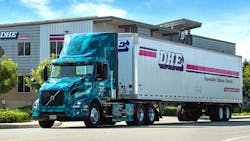Early adopter fleet opens up about EV range, charging in real world
Many unknowns remain as the commercial vehicle industry continues its journey toward a totally decarbonized future. Howbeit, pioneers who are trucking ahead, voluntarily or otherwise, by integrating EVs into their fleets, are starting to answer some of these questions or, at the very least, even know what to ask. Here’s how DHE is embracing California’s emissions regulations:
California fleets have known what’s coming in terms of emission regulations for a while. Some may have held out hope the lawsuit filed by the Truck and Engine Manufacturers Association against CARB to halt stricter 2024 emissions standards would go somewhere (it didn’t), or that the Golden State would get tired of going green (it won’t). Dependable Highway Express decided early on to take electrification seriously and embrace it from the beginning, making it well-prepared for the coming ACF mandates.
The carrier operates 400 less-than-truckload assets, 100 in truckload, and another 100 in drayage. DHE beta-tested VNR Electric prototypes through Volvo’s LIGHTS project and has two first-gen production models and one new second-gen extended-range version operating out of its Ontario, California terminal.
Right now, DHE is figuring out two of the most pressing issues: range and charging capabilities. If a fleet can’t answer how far a truck can go and how to power it, it’s not very dependable.
Because DHE has operated Class 8 EVs since 2020, Troy Musgrave, director of process improvement at Dependable Supply Chain Services, has a good idea of these capabilities.
See also: ABM debuts integrated EV charging solution
Testing out their EVs themselves has allowed the fleet to truly measure what the batteries can do. The gen-1 VNR Electric has a marketed range of up to 150 miles, though that does not mean the truck, which has a 264-kW battery, gets close to that on one charge.
“The first thing you have to do is remove 20% [capacity], because the battery holds that in reserve,” Musgrave explained. “You’ve got 211 kWh to use. In my experience, they also advertise 1.8 kWh per mile—and that might be what the truck consumes, but when you add in standby power—all that power that’s required to put the energy in the truck—it’s more like 2 [kWh per mile].”
This is a technical way to say DHE’s older VNR Electrics get about 105 miles per charge. These are in LTL applications; fully loaded trailers would diminish this performance even more. The extended-range version ups battery energy storage to 565kWh, for a marketed max range of 275 miles. It features an improved design (with six battery packs) for faster charging. It can receive 250kW in one hour, according to Volvo.
DHE has not tested the extended range’s upper limits just yet, as they received the truck 45 days before speaking with Fleet Maintenance. But Musgrave intends to push the range limits when given the opportunity. He expects the range to max out at around 238 miles.
This is not to say these trucks’ daily routes are limited by one battery charge.
“We’re getting anywhere from 85 miles to as high as 180 miles [on the first-gen trucks], and we do that through opportunity charging,” Musgrave said. “Even 15 to 20 minutes on a 150-kW charger will put a significant amount of energy back in.”
Opportunity charging occurs when drivers return to the terminal for lunch or a break. And up until 80% full, the battery accepts energy at a greater rate.
“Once it gets up to about 80% capacity, the length of time it took you to go from 20% to 80% will be as long to go from 80% to 100%, because the [charger software] throttles it way down to fill up that last little bit.”
Musgrave doesn’t plan on getting any more Class 8 trucks with the gen-1 batteries. Diesels just offer more flexibility for day and night routes.
“At night, the truck is traveling anywhere from 300 to 500 miles and in the daytime, it’s traveling up to 200 miles,” Musgrave noted.
He envisions a scenario where technology improves enough so that the fleet can operate from southern to central California with only EVs, with drivers changing out depleted trucks with fully charged ones and continuing on, “like the Pony Express,” Musgrave mused.
“You don’t need a bunch of trucks; you just need enough trucks and a scheduling format that can get you to the next place,” he continued.
The Tesla Semi, currently running routes in Pepsi’s fleet, boasts a purported 500-mile range, which Musgrave noted exceeds certain hydrogen fuel cell trucks’ 400-mile range. The issue with Tesla will be how fast they can fulfill orders.
“I’ve got an order for 10 of them,” Musgrave said. “And I don’t know if I’ll see them before I retire.”
About the Author

John Hitch
Editor-in-chief, Fleet Maintenance
John Hitch is the award-winning editor-in-chief of Fleet Maintenance, where his mission is to provide maintenance leaders and technicians with the the latest information on tools, strategies, and best practices to keep their fleets' commercial vehicles moving.
He is based out of Cleveland, Ohio, and has worked in the B2B journalism space for more than a decade. Hitch was previously senior editor for FleetOwner and before that was technology editor for IndustryWeek and and managing editor of New Equipment Digest.
Hitch graduated from Kent State University and was editor of the student magazine The Burr in 2009.
The former sonar technician served honorably aboard the fast-attack submarine USS Oklahoma City (SSN-723), where he participated in counter-drug ops, an under-ice expedition, and other missions he's not allowed to talk about for several more decades.
